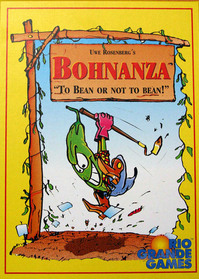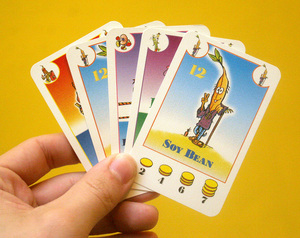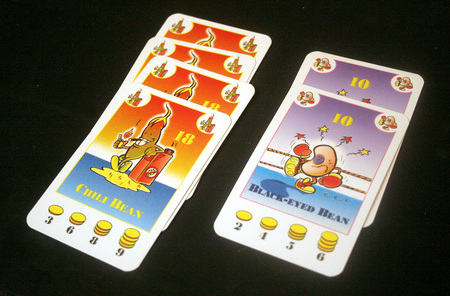Bohnanza: Somehow a bean farming card game is fun

I’ll say straight away that Bohnanza does not look like a fun game. The cover features a cartoon bean in overalls hacking away indiscriminately at some dirt with a hoe. Yes, it’s a game about bean farming and trading and if I were you, I would think about skipping over clicking the “More after the jump…” link, but hear me out here.
At it’s heart, Bohnanza is a game about collecting as many of two types of beans as you can. The more that you can collect, the higher payout that you’ll get when you harvest them to plant a new type. There’s a lot working for you and a lot working against you, but with some trading and strategy, you’ll end up with the most points at the end of the game. Let’s take a look at everything happening in the game.
You start your bean farming career with five cards in your hand. Unlike other games you’ve played, you are not allowed to reorganize the cards in your hand. The order that the cards are in are the order in which they will be played. On your first turn, you’ll play your first card and then you may play your second card if you would like.

Mike Hulsebus | Contributor
In front of you have only two places to play cards and each “field” can only have one type of bean in it. So you’re not only trying to collect as many of a certain type as you can, but also you’re also trying to make it so you aren’t forced to plant cards that you don’t want. If you’re forced to plant a bean, you’ll have to harvest that big set of other beans you’ve been collecting to make room for that new bean. So in the image at right, if I don't want to plant the two cards between my soybeans, I'll want to try and trade them away before my next turn. More on trading as we go on.
On the next part of your turn. You reveal two cards from the top of the deck to all the players. If these are beans that you’re collecting, you can take them and plant them immediately. If they aren’t, you can trade them away to the other players. They can offer you beans from their hand that are ones you’re looking for. You have motivation to trade because you don’t want to have to plant those cards. They have motivation to trade for the same reason: if they can clear the cards out of their hands before they have to plant them, they’ll also be in good shape.
Yes, you could opt not to trade with someone so that they’re forced to plant a bean they don’t want, but Bohnanza is a game where players are most often doing trades that are advantageous to them. The winner will be the player that gets the most value out of his trades. The less frequently that a bean appears, the more that that bean is worth so there rarely is a trade that is exactly even in value.
When you harvest beans, you earn coins based on the number of cards that you have already taken. The backs of cards show coins on them, and you hold back cards equal to that field’s value. The rest get discarded.

Players can have up to two bean fields in front of them. Note how there are fewer black-eyed beans in the deck (10 compared to 18) and how a player needs fewer cards in order to score coins for the black-eyed bean. Here, since the player has 2 black-eyed beans, it could be harvested for 1 coin.
Mike Hulsebus | Contributor
Once the deck has been gone through three times, the game is over and whoever has the most coins wins. At first glance, it seems pointless to go through the deck so many times, but it’s actually quite smart. Since the cards themselves become the coins, there are fewer cards in the deck on the second round and players know that the rarer cards are even rarer since as many as half of them have been converted to coins.
I like Bohnanza as a game to play with a larger number of players. The game plays 3-7 players and, unlike other games that support so many players, people don’t have a lot of downtime. In a poorly designed turned based game with seven players, you might feel like you’re only really playing one seventh of the time, the rest being sitting and waiting to get to do something. In Bohnanza though, with the trading that goes on, there’s always something to be involved in. That’s a huge strength and does a lot to really make this game fun.
The game is also well balanced: The beans available in the deck are different depending on the total number of players playing, so the game isn’t as dramatically different as you would expect it to be with the wide variety of players that it plays.
The game is more than twice as long (about 45 minutes plus however long it takes you to explain it) than last week’s game, No Thanks, so in choosing a game, I would look at how much time the players are willing to invest in a game. No Thanks is a great filler game, whereas Bohnanza might be a good game to play if it’s the one game you might want to teach non-gamers in an evening. It’s not an overly complex game, but it takes more time to explain and certainly more time to play. The last four times I’ve played, we’ve always gone though the deck two times rather than three in the interest of time.
So yes, the cover of a bean farming itself is weird in the way that those pig eating itself ads are. But if you’re looking for a card game that actually plays well with a lot of players, Bohnanza is a good choice. You might have to do some work to convince them it's fun once they see the box and hear about the theme, but it's worth it.
Mike Hulsebus is going to build a medieval warfare board game with a cover featuring a castle sieging itself. The follow up board game will have a cover of that board game selling itself. Investors can contact him at mikehulsebus@gmail.com.

